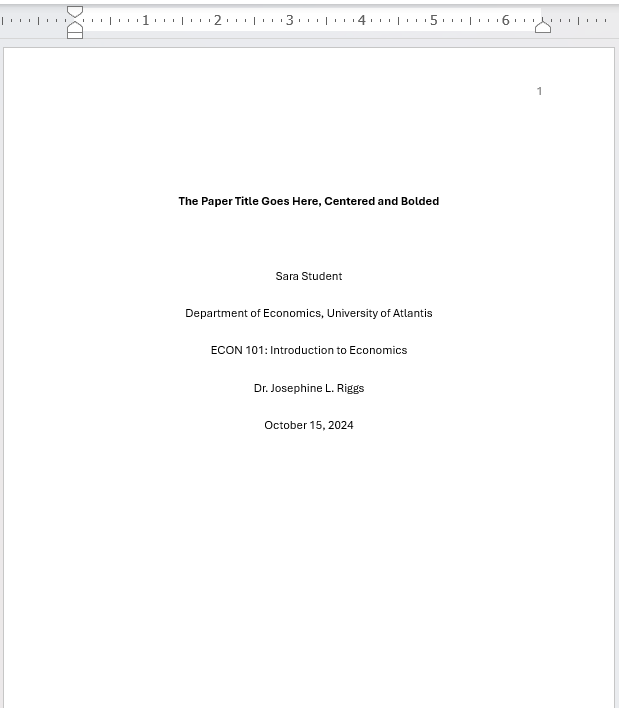A Simple Guide on APA Style Title Pages
The title page is the first impression of a paper. It gives prospective readers a sense of what to expect and lets them know whether they should continue reading the paper or not. Thus, it is important to make a good first impression with the title page.
The American Psychological Association (APA) has specific guidelines for formatting a title page (also called a cover page). These guidelines help standardize scientific papers, making them easier for readers to navigate.
The APA title style title page has general requirements, but it requires different components for student papers as compared to professional ones. All of these formatting styles will be covered below.
APA Style Title Pages for Different Groups (7th edition)
General Requirements for APA Style Title Pages
The general requirements for an APA style cover page are relevant for both student and professional papers. These include page numbers, the title of the paper, and the authors’ full names and institutional affiliations.
The first component of the title page is the page number. The page number, 1, should be in the upper-right corner of the title page. The following pages of the document should also include page numbers.
The title should be typed in the center in the upper half of the page. In other words, the title should be horizontally centered across the page and positioned in the middle half of the page. It should be formatted with boldface. All text on the title page should be double-spaced.
The APA recommends a title that is focused and concise. It should not include any abbreviations or filler words. APA style titles generally take up one or two lines. They should not be longer than two lines.
Placed below the title, include the author’s name. Specifically, this includes the first name, middle initial(s), and the last name. Titles and degrees (e.g., PhD, MD, MS) are not included on the title page. If the title includes multiple authors, they should be ordered in terms of contribution, such that the first author wrote the majority of the paper, and subsequent authors contributed less. In some disciplines, the last author is considered a “senior author” and served as a guide or mentor for the project.
Moreover, in some cases, authors may equally contribute to a paper. When all authors equally contribute, the authors are listed in alphabetical order by last name. When only some authors equally contributed to the paper, those authors may be designated with a symbol, such as an asterisk. Beneath the list of authors, a note is used to explain that the asterisk indicates which authors shared the same amount of responsibility (e.g., the first two authors worked the most on the paper).
In professional papers, the order of the list of authors is often important because it signifies who takes the credit for the bulk of the work. In medicine and psychology, for example, first authors are responsible for the work, and last authors generally guide the direction of the paper.
After including authors’ names, type the institutional
affiliations, or where the authors completed the research. Institutional
affiliations typically include the department and name of the school or
organization (e.g., Department of Medicine, Bright Future University). The city
and state of the university are also requested for some cover pages. In some
cases, authors may contribute to the paper from various institutions, and
superscripts are typically used to specify each author’s location.
APA Style Title Page for Student Papers
Students may need to write in APA style and will need to write a cover page. The cover page for student papers should include all components mentioned above in the “General Requirements for APA Style Title Pages.” Namely, student papers must include a title, the authors’ names, and authors’ institutional affiliation. These papers also require a few specific components.
Student papers necessitate information that details the assignment. For example, this normally includes the name of the course for which the paper was written, the name of the instructor of the course, and the due date of the writing assignment. This information should be placed beneath the title.
To recap, a student cover page in APA format requires a page number, the title of the page, the full name of the author(s), and institutional affiliations. It also includes the name of the course for which the paper was written, the name of the instructor of said course, and the assigned due date for the paper.

APA Style Title Page for Professional Papers
Instead of turning the paper in for a class assignment, some papers are submitted for publication in academic journals. These professional papers require slightly different components than student papers. Professional papers require all the components mentioned in the “General Requirements for APA Style Title Pages” section, and they require a few additional sections.
At the top of a professional paper, a running head is required. The running head should be placed in the top left of the title page. It is a shortened version of the full title. The running head summarizes the title in just a few words. It should capture the gist of the title and is essentially a subtitle. Importantly, the running head cannot exceed 50 characters, and this includes all spaces and punctuation.
The running head section shares heading space with the page number. While the running head is justified to the left of the title page, the page number must be placed in the top right of the title page.
Differing from student papers, professional papers also require an author note. The author note is placed beneath the institutional affiliations. Author notes generally include information about the authors’ research profiles, such as their ORCID and URL for their ORCID. The author note also includes the authors’ institutional affiliations. The note indicates if any of the authors died during the writing or publication process. Then, the note details disclosures, such as conflicts of interest, and acknowledgements.
In the acknowledgements, authors indicate financial support from grant funding and any other assistance. Moreover, they include study registrations, data sharing practices, and open science declarations. Lastly, and importantly, the author note provides information for the corresponding author, which is typically the email of the person to contact for questions or further information about the paper.

In summary, a professional cover page in APA format requires a running head with a shortened title, a page number, the title of the paper, and an author note. Within the author note, there is the full name of the authors, the authors’ institutional affiliations, and other important information about the paper. The author note can also include ORCID iDs, any changes in author affiliation, and study details.
Resources and Further Reading for APA Style Title Pages
Many online resources are available to help with formatting an APA style title page. For student papers, online blogs give students several examples for formatting their title pages. A key resource to help students with specific writing formats, including APA style, is Purdue OWL. This resource is maintained by Purdue University and is called the Purdue Online Writing Lab (OWL). There are various other online resources for writing APA style title pages, such as Grammarly.
Notably, these resources also provide information about writing professional APA cover pages. However, given that these professional papers are often submitted to academic journals, the journals require a specific format that may be slightly different from that of APA. The best way to get examples for professional papers is to visit professional, academic journals that are displayed online. When writing a professional paper for a specific academic journal, it is best to visit their page for specific guidelines. The APA provides examples for preparing a professional paper in APA style format.
Briefly, writing an APA style title page requires different components for student papers as compared to professional ones. However, the general requirements include a title, page numbers, and authors’ names and institutional affiliations.